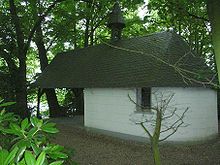Irmund von Jülich
Irmund von Jülich (Irmonz, also Irmund von Mündt, around 4th century) is considered the popular saint and patron saint of cattle. He is depicted in a hermit's robe with a shepherd's staff and various cattle . Its name is derived from Anglo-Saxon and means "great" and "protection".
Irmund's life dates are unknown. He is said to have lived as a shepherd and hermit in the 4th century at the time of Cologne Bishop Severin on the Hahnerhof east of the Titz district of Mündt . A spring on the farm used to have healing properties. Irmund is credited with introducing Christianity to this region. There is evidence of a church in Mündt as early as 650, the predecessor of today's St. Urban Church . Today's pond on the Hahnerhof is artificially irrigated as a result of the swamp measures by the neighboring Garzweiler opencast mine .
Adoration
The name day in the Catholic Church is January 28th.
A chapel built on Hahnerhof in 1672 with a baroque high altar was a destination for pilgrimages in the surrounding area in centuries past . Irmund's relics are still exhibited there on certain festive days . In 1685 the Irmundus Cross was erected on a field path in the direction of Mündt south of the Hahnerhof. In 1998 the cross was restored and repositioned. The parcel “Am alten Kirchhof” is said to have been the location of the old town of Munda.
literature
- Ekkart Sauser : Irmund (Irmonz) from Jülich. In: Biographisch-Bibliographisches Kirchenlexikon (BBKL). Volume 17, Bautz, Herzberg 2000, ISBN 3-88309-080-8 , Sp. 673-674.
- Dieter PJ Wynands: Irmundus vom Hahnerhof - Notes on the Vita and Cult of a Saint of the Jülich Land , In: Rheinisch-Westfälische Zeitschrift für Volkskunde 49 (2004), pp. 257–268.
Web links
| personal data | |
|---|---|
| SURNAME | Irmund von Jülich |
| ALTERNATIVE NAMES | Irmonz; Irmund von Mündt |
| BRIEF DESCRIPTION | Folk saint and patron saint of cattle |
| DATE OF BIRTH | 4th century |
| DATE OF DEATH | 4th century |
